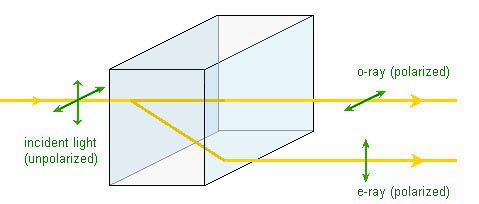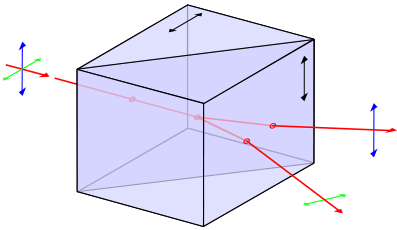Birefringence and the polarized light
1. Definition
Birefringence is a kind of optical phenomenon that when the light go through an anisotropic crystals, there are two emergent refracted lights as the different refractive index along directions. The light obey to the Snell’s law is known as the ordinal (o) ray, while the other one is known as extraordinal (e) ray, as shown in Fig. 1 [1]. The direction of o ray vibration is perpendicular to the incident plane, while that of e ray is in the incident plane. 
Fig. 1 Schema of birefringence [1]
For birefringence, we first should know that it was caused by the anisotropic refractive index along different diffraction. As the effect of birefringence, the unpolarized light can be separated into two polarized light with perpendicular directions of vibration. The birefringence phenomenon can be applied in polarizer!
2. Application in polarizer
The unpolarized light is always a ray with magnetic-electric waves vibrated in all directions. As the effect of birefringence, the unpolarized light can be separated into two groups: s- polarized light with the wave vibration perpendicular to the principle plane and p- polarized light with the wave vibration in the principle planed. Notice that s- and p- polarized are not characteristics for a light ray, it always related to certain incidence plane! A typical example for a polarizer according to the optical birefringence is the Wollaston prism, shown in Fig. 2 [2], which uses two calcite prisms to separate the unpolarized light. Then how to define the obtained two linearly polarized light? We come to the Brewster angle.
Fig. 2 The schema of the Wollaston prism [2]
3. Brewster angle
Brewster angle is defined as that at certain incident angle all the linear polarized light in the principle plane (p- polarized light) can transmit through the surface without any reflection [3]. Thus at the reflection directions only s- polarized light can be detected. This can be used to distinguish certain linear polarized light to be s- or p- polarized light.
References
[1] http://plc.cwru.edu/tutorial/enhanced/files/lc/biref/biref.htm
[2] http://en.wikipedia.org/wiki/Wollaston_prism
[3] http://www.u-oplaz.com/crystals/crystals01.htm<?xml:namespace prefix = o ns = "urn:schemas-microsoft-com:office:office" />
Birefringence and the polarized light






Comments